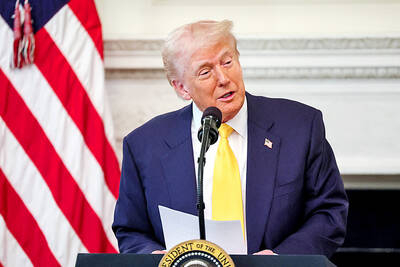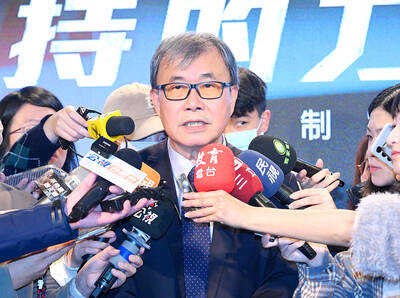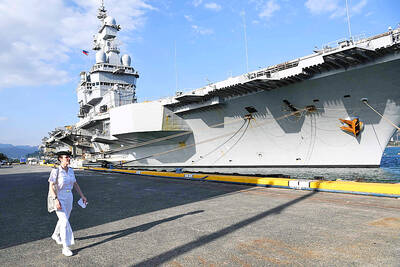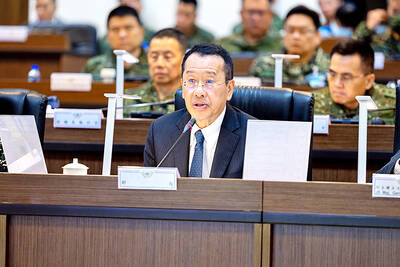Energy giants Chevron, Shell and ExxonMobil yesterday agreed to develop Australia’s massive Gorgon field, giving the final go-ahead to a liquefied natural gas (LNG) project worth hundreds of billions of dollars.
Chevron said the joint venture partners would start work immediately on the plant, pumping A$43 billion (US$37 billion) into the initial construction phase.
Australian Prime Minister Kevin Rudd said the project off the nation’s northwest, which is expected to begin production in 2014, would provide a valuable source of jobs and exports.

PHOTO: AFP
“The Gorgon investment will be Australia’s largest-ever resources development and is expected to generate 300 billion [Australian] dollars in Australian export earnings,” he said in a statement.
The project is already underpinned by supply contracts with China, Japan, India and South Korea worth a combined A$145 billion, including ExxonMobil’s record A$50 billion deal with PetroChina.
“Gorgon will supply cleaner burning natural gas for the growing Asia-Pacific and Australian markets, create thousands of jobs and generate substantial revenue for Australia,” senior Chevron executive Jim Blackwell said.
Gorgon, the world’s largest LNG plant, will be built on Barrow Island, a nature reserve about 70km off Western Australia.
The Australian government approved the project last month after imposing strict environmental conditions.
ExxonMobil said Gorgon had an estimated 40 trillion cubic feet of natural gas, providing an important source of energy for Asia’s burgeoning economies.
“With global demand for LNG forecast to triple by 2030, the Gorgon project will be a critical supply source in meeting this future demand, particularly for the economies in the fast-growing Asia-Pacific region,” ExxonMobil senior executive Neil Duffin said.
Chevron owns a 50 percent stake in Gorgon and will operate the plant, with ExxonMobil and Shell each holding 25 percent.
Chevron said it was set to award more than A$10 billion in construction contracts in coming months as building work gets under way.
Rudd predicted immense economic benefits for Australia, with the project set to boost government revenues by A$40 billion over the next 30 years, generating 10,000 construction and 3,500 permanent jobs.
“Gorgon will help to stimulate Australia’s economic growth and provide energy security for many decades,” he said.
Macquarie economist Hayden Atkins said the mammoth project had positive growth implications for the entire economy.
“This provides upside to both near and medium-term growth projections,” the economist told Dow Jones Newswires.
Rudd also praised Gorgon’s environmental credentials, saying plans to pump excess emissions into rock 2km beneath Barrow Island would make it the world’s biggest carbon dioxide geological storage project.
He said economies that used LNG rather than coal to generate energy also significantly reduced their greenhouse gas emissions.
Gorgon is just one of a clutch of LNG projects planned in Western Australia and Queensland over the next decade that analysts say will see Australia challenge Qatar as the world’s major gas exporter.
Australia exported 15.2 million tonnes of LNG valued at A$5.2 billion in 2006, a figure the government estimates will quadruple to 60 million tonnes by 2015 if all planned projects proceed.
The gas is liquefied for shipping abroad, where it is turned back into gas and distributed via a pipeline.

STILL COMMITTED: The US opposes any forced change to the ‘status quo’ in the Strait, but also does not seek conflict, US Secretary of State Marco Rubio said US President Donald Trump’s administration released US$5.3 billion in previously frozen foreign aid, including US$870 million in security exemptions for programs in Taiwan, a list of exemptions reviewed by Reuters showed. Trump ordered a 90-day pause on foreign aid shortly after taking office on Jan. 20, halting funding for everything from programs that fight starvation and deadly diseases to providing shelters for millions of displaced people across the globe. US Secretary of State Marco Rubio, who has said that all foreign assistance must align with Trump’s “America First” priorities, issued waivers late last month on military aid to Israel and Egypt, the

‘UNITED FRONT’ FRONTS: Barring contact with Huaqiao and Jinan universities is needed to stop China targeting Taiwanese students, the education minister said Taiwan has blacklisted two Chinese universities from conducting academic exchange programs in the nation after reports that the institutes are arms of Beijing’s United Front Work Department, Minister of Education Cheng Ying-yao (鄭英耀) said in an exclusive interview with the Chinese-language Liberty Times (the Taipei Times’ sister paper) published yesterday. China’s Huaqiao University in Xiamen and Quanzhou, as well as Jinan University in Guangzhou, which have 600 and 1,500 Taiwanese on their rolls respectively, are under direct control of the Chinese government’s political warfare branch, Cheng said, citing reports by national security officials. A comprehensive ban on Taiwanese institutions collaborating or

France’s nuclear-powered aircraft carrier and accompanying warships were in the Philippines yesterday after holding combat drills with Philippine forces in the disputed South China Sea in a show of firepower that would likely antagonize China. The Charles de Gaulle on Friday docked at Subic Bay, a former US naval base northwest of Manila, for a break after more than two months of deployment in the Indo-Pacific region. The French carrier engaged with security allies for contingency readiness and to promote regional security, including with Philippine forces, navy ships and fighter jets. They held anti-submarine warfare drills and aerial combat training on Friday in

COMBAT READINESS: The military is reviewing weaponry, personnel resources, and mobilization and recovery forces to adjust defense strategies, the defense minister said The military has released a photograph of Minister of National Defense Wellington Koo (顧立雄) appearing to sit beside a US general during the annual Han Kuang military exercises on Friday last week in a historic first. In the photo, Koo, who was presiding over the drills with high-level officers, appears to be sitting next to US Marine Corps Major General Jay Bargeron, the director of strategic planning and policy of the US Indo-Pacific Command, although only Bargeron’s name tag is visible in the seat as “J5 Maj General.” It is the first time the military has released a photo of an active